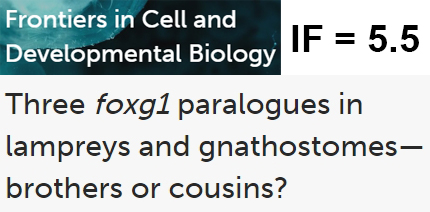Press-room / news / Science news /
Multiple paralogs of foxg1, the regulator of forebrain development, in lampreys and sturgeons: the legacy of genomic duplications in the early evolution of vertebrates
The forebrain of vertebrates, including its unique rostral section, the telencephalon, provides the highest forms of nervous activity in animals and humans. The foxg1 gene has been described as one of the leading regulators of early forebrain development. It has been shown that disturbances in the expression of foxg1 lead to developmental abnormalities and a decrease in the size of the forebrain, called FOXG1 syndrome in humans.
Previously, most vertebrates and their closest relatives were considered to have a single foxg1 gene which is often used as a molecular marker of the forebrain and associated structures.
In our article published in Frontiers in Cell and Developmental Biology, we first described the presence of multiple foxg1 paralogs in lampreys, as representatives of the most evolutionarily ancient group of vertebrates – jawless, and sturgeon, as one of the archaic clade of gnathostomes.
To assess the relationship of foxg1 genes in lampreys and gnathostomes, an analysis of their local genomic synteny (Figure 1), a phylogenetic analysis of the proteins they encode, and a study of the expression patterns of foxg1 paralogs in river lamprey and sterlet were carried out.
It was shown that the situation of the presence of one foxg1 gene observed in higher vertebrates (birds, mammals and some reptiles) is not basic for vertebrates. In phylogenetically ancient groups - cartilaginous, sturgeons and bony fishes, as a rule, three foxg1 paralogs are present. Some representatives have two genes left (C. milii), and teleost fish, due to additional genomic duplication, have four foxg1 paralogues. Since one foxg1 gene was found in the closest relatives of vertebrates (lancelets and tunicates), it was hypothesized that the three vertebrate foxg1 genes appeared as a result of two rounds of genomic duplications in the early evolution of vertebrates. This hypothesis was confirmed by assessing the timing of duplication of foxg1 paralogs in different vertebrate groups.
Spatial expression analysis revealed that all three lamprey foxg1 genes are expressed in the telencephalon, although foxg1 gene expression patterns differ (Figure 2). In the sterlet, only the foxg1a gene is expressed in the forebrain.
The detected expression of foxg1 genes in the procephalic structures, sensory organs and cranial nerves of agnathans and gnathostomes may indicate an important evolutionary role of foxg1 genes in the formation of the structural plan of these morphological characters of vertebrates. At the same time, we did not find a reliable pairwise orthology between individual foxg1 paralogues of agnathans and gnathostomes, which could indicate in favor of the hypothesis of one or two rounds of general whole-genome duplication before the separation of these evolutionary lines.
It has been established that the identified phylogeny of sturgeon foxg1 paralogues corresponds to the model of ancestral duplication followed by asynchronous rediploidization, and the duplication of the foxg1b genes before the separation of the Polyodon and Acipenser lineages indicates a genomic duplication that occurred at the level of their common ancestor.

Figure 1. Local genome synteny analysis of foxg1 genes of vertebrate.

Figure 2. Expression of the foxg1 paralogs in river lamprey (agnathans) and sterlet (sturgeons).
january 25


